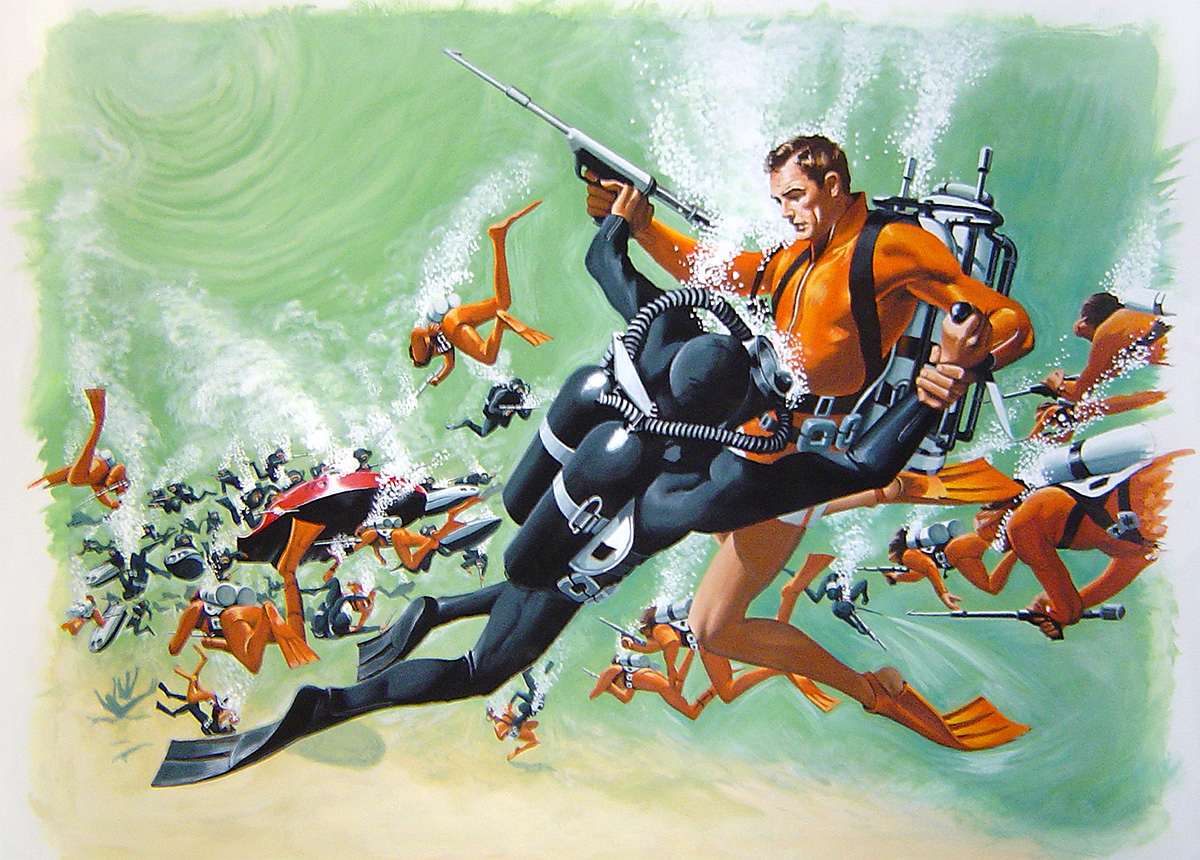Thunderball (1965, Dir. Terence Young):
‘When I came to the table I saw a SPECTRE.’ He said the word casually, with no hint at double meaning.
The smile came off Largo’s face as if he had been slapped. It was at once switched on again, but now the whole face was tense, strained, and the eyes had gone watchful and very hard. His tongue came out and touched his lips. ‘Really? What do you mean?’
Bond said lightly, ‘The SPECTRE of defeat. I thought your luck was on the turn. Perhaps I was wrong.’ He gestured at the shoe. ‘Let’s see.’
The table had gone quiet. The players and spectators had felt that a tension had come between the two men. Suddenly there was the smell of enmity when before there had been only jokes. A glove had been thrown down, by the Englishman. Was it about the girl? Probably. The crowd licked its lips.
— Ian Fleming, Thunderball
Set the way-back machine to 1965: Danger Man, I Spy, Get Smart, The Avengers (think Emma Peel, not Thor and the Hulk) and The Man from U.N.C.L.E. on the telly. Dean Martin and James Coburn getting ready to party it up in the Matt Helm and Flint movies. Richard Burton glowering his way through The Spy Who Came In From the Cold. Michael Caine sassing it up as Sgt. Harry Palmer in The Ipcress File. It’s fair to say that the planet was a little spy-crazy in 1965 — and what better way to conclude that manic year than with the release of the fourth James Bond film Thunderball, which premiered just before Christmas? This was the Star Wars or Avengers (yep, the one with the Hulk and Thor) of its day; dominating theaters, it made nearly fifteen times its production costs ($1 billion in ticket sales, inflation adjusted for today).
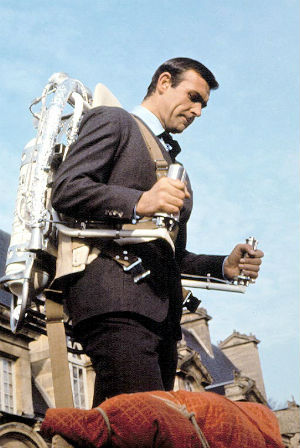 Bond may have been the undisputed box office king — but with every king there lies an uneasy head under the crown. While Bond producers Albert Broccoli and Harry Saltzman knew that other spy franchises would sprout like weeds, they probably didn’t anticipate that the biggest threat to their burgeoning empire would be, well, Bond himself. Producer Kevin McClory had collaborated with Ian Fleming and Jack Whittingham on an aborted Bond screenplay in the late ’50s, which Fleming later cannibalized for the ninth Bond novel Thunderball — without giving credit to McClory or Whittingham. One lawsuit later, McClory was granted credit for inspiring the novel, as well as the rights to produce a film version. With the astronomical success of Goldfinger, McClory felt the time was ripe to jump on the Bondwagon, and announced his intentions to bring his own version of Her Majesty’s Secret Servant to screen. Broccoli and Saltzman, leery of such direct competition, decided to head McClory off at the pass, and struck a deal to co-produce Thunderball with him.
Bond may have been the undisputed box office king — but with every king there lies an uneasy head under the crown. While Bond producers Albert Broccoli and Harry Saltzman knew that other spy franchises would sprout like weeds, they probably didn’t anticipate that the biggest threat to their burgeoning empire would be, well, Bond himself. Producer Kevin McClory had collaborated with Ian Fleming and Jack Whittingham on an aborted Bond screenplay in the late ’50s, which Fleming later cannibalized for the ninth Bond novel Thunderball — without giving credit to McClory or Whittingham. One lawsuit later, McClory was granted credit for inspiring the novel, as well as the rights to produce a film version. With the astronomical success of Goldfinger, McClory felt the time was ripe to jump on the Bondwagon, and announced his intentions to bring his own version of Her Majesty’s Secret Servant to screen. Broccoli and Saltzman, leery of such direct competition, decided to head McClory off at the pass, and struck a deal to co-produce Thunderball with him.
With a relatively inexperienced producer in tow, legions of obsessed fans to satisfy, and faced with a mounting challenge — how do we top the last one? — the Bond franchise responded by upping the ante. Splicing together elements from all three previous entries (Dr. No‘s tropical locales and outdoor action, From Russia with Love‘s more serious approach, Goldfinger‘s glamour and gadgets), Thunderball is 007 on steroids, ballooned to a 2+hour running time — the longest Bond film at the time, by a wide margin. The plot, lifted straight from Fleming’s novel, is archetypal Bond: SPECTRE, up to its usual nefarious tricks, hijacks a NATO bomber and holds the world to nuclear ransom. The only lead MI-6 has is Domino (Claudine Auger), the beautiful (natch) sister of one of the bomber’s missing pilots, with Bond’s investigation putting him on the trail of Largo (Adolfo Celi), SPECTRE’s Number Two man and the mastermind behind the scheme. Toss in copious amounts of underwater action, another save-the-world finale, and Connery at the peak of his popularity, and you have something that couldn’t miss, and didn’t.
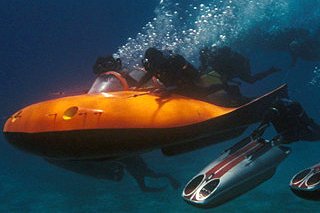 Say this for Thunderball: it doesn’t skimp on scale. While the lengthy aquatic sequences grow repetitive and may tax one’s patience, they’re handsomely photographed by Lamar Boren. The beaches, casinos, and azure waters of the Bahamas are as lush as Bond films had gotten to that point. Production designer Ken Adam was feeling his oats, proving himself equally comfortable with the granular (the submersibles and deadly toys Bond plays with) and the grand (the cavernous double-oh-agent briefing room, or the sharp lines and metallic surfaces of SPECTRE’s Paris lair). The script is more workmanlike than inspired, but it doesn’t skimp on the humor — Bond gets to toss out some of his best throwaway quips in this one, whether he’s perforating a nosy henchman (“I think he got the point”) or needling Largo during a congenial skeet game (“That gun looks more fitting for a woman.” “You know much about guns, Mr. Bond?” “No, I know a little about women”). Even as the plot grows slack, we’re treated to some of the more memorable action sequences the series has offered: a tussle with a very peeved widow who happens to be a SPECTRE agent (“I don’t think you should have opened that car door by yourself”); a chase through the Junkanoo parade that prefigures similar chases in On Her Majesty’s Secret Service, Moonraker, and SPECTRE; a close encounter between Connery and a shark that was unplanned; and a final tussle aboard an out-of-control hydrofoil that sees Bond take on four men at once — quite successfully, we might add.
Say this for Thunderball: it doesn’t skimp on scale. While the lengthy aquatic sequences grow repetitive and may tax one’s patience, they’re handsomely photographed by Lamar Boren. The beaches, casinos, and azure waters of the Bahamas are as lush as Bond films had gotten to that point. Production designer Ken Adam was feeling his oats, proving himself equally comfortable with the granular (the submersibles and deadly toys Bond plays with) and the grand (the cavernous double-oh-agent briefing room, or the sharp lines and metallic surfaces of SPECTRE’s Paris lair). The script is more workmanlike than inspired, but it doesn’t skimp on the humor — Bond gets to toss out some of his best throwaway quips in this one, whether he’s perforating a nosy henchman (“I think he got the point”) or needling Largo during a congenial skeet game (“That gun looks more fitting for a woman.” “You know much about guns, Mr. Bond?” “No, I know a little about women”). Even as the plot grows slack, we’re treated to some of the more memorable action sequences the series has offered: a tussle with a very peeved widow who happens to be a SPECTRE agent (“I don’t think you should have opened that car door by yourself”); a chase through the Junkanoo parade that prefigures similar chases in On Her Majesty’s Secret Service, Moonraker, and SPECTRE; a close encounter between Connery and a shark that was unplanned; and a final tussle aboard an out-of-control hydrofoil that sees Bond take on four men at once — quite successfully, we might add.
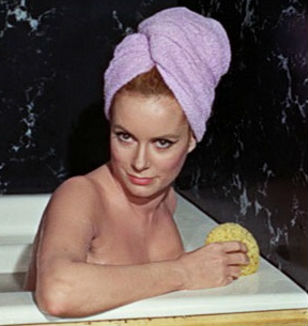 That runaway boat could be taken as a metaphor for where the Bond series was headed. Crafted as a mass audience-pleaser, Thunderball has a machine-like efficiency in its adherence to formula, but who’s at the steering wheel? It’s not director Terence Young, who does just enough to keep the gears grinding but doesn’t gift the film with much personality. (At the conclusion of production, he reportedly said to the producers, “You don’t need a director, you need a bloody M.I.T. graduate to handle all the technology.”) Compared to the colorful characters who populated the first three Bond movies, the cast in Thunderball is cookie cutter. Apart from one scene where she gets to emote, the fetching Auger is reduced to eye candy. Celi sports a nifty eyepatch as Largo, but when it comes to memorable quirks or menace, he’s second-tier. Even Connery seems muted, as if he realizes Bond’s only function in this movie is to swim well and look pretty. The sole character with some life to her is Luciana Paluzzi’s Fiona Volpe, certainly not the first but most certainly the best of all the female baddies 007 has ever faced. Throwing Bond’s sexual prowess back in his face (“What a blow it must have been — you have been a failure”), taking a careless drag on her ciggy as she plots his doom, or taking out a substandard SPECTRE agent with a motorbike and a well-aimed missile, she’s just as devil-may-care as our hero — which of course necessitates her being offed before the final reel.
That runaway boat could be taken as a metaphor for where the Bond series was headed. Crafted as a mass audience-pleaser, Thunderball has a machine-like efficiency in its adherence to formula, but who’s at the steering wheel? It’s not director Terence Young, who does just enough to keep the gears grinding but doesn’t gift the film with much personality. (At the conclusion of production, he reportedly said to the producers, “You don’t need a director, you need a bloody M.I.T. graduate to handle all the technology.”) Compared to the colorful characters who populated the first three Bond movies, the cast in Thunderball is cookie cutter. Apart from one scene where she gets to emote, the fetching Auger is reduced to eye candy. Celi sports a nifty eyepatch as Largo, but when it comes to memorable quirks or menace, he’s second-tier. Even Connery seems muted, as if he realizes Bond’s only function in this movie is to swim well and look pretty. The sole character with some life to her is Luciana Paluzzi’s Fiona Volpe, certainly not the first but most certainly the best of all the female baddies 007 has ever faced. Throwing Bond’s sexual prowess back in his face (“What a blow it must have been — you have been a failure”), taking a careless drag on her ciggy as she plots his doom, or taking out a substandard SPECTRE agent with a motorbike and a well-aimed missile, she’s just as devil-may-care as our hero — which of course necessitates her being offed before the final reel.
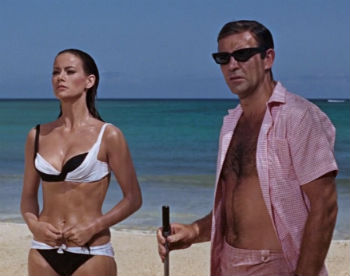 Thunderball might make gestures towards urgency — nuclear apocalypse is imminent, after all — but it’s more about celebrating its bigness, its Bond-ness, its travelogue settings and hourglass-shaped women. This is not to say it’s a failure; Young is too accomplished a craftsman not to piece together a professional product, and it’s one of the rare entries in the series that takes its central premise seriously. Something more brisk and less plodding would have been welcome, though. Up to this point Bond movies had been genial, unpretentious entertainments; in Thunderball, everyone involved is all too aware that they’re part of a phenomenon, and that awareness hangs heavy in the air, as heavy as Tom Jones warbling the main theme. When we arrive at the big finish, with dueling frogmen, sharks and destroyers swirling off the shores of Miami, you can practically smell the battle fatigue of the production crew. It’s like a trust fund baby throwing his money around, nervous about the other rich cats moving into the neighborhood.
Thunderball might make gestures towards urgency — nuclear apocalypse is imminent, after all — but it’s more about celebrating its bigness, its Bond-ness, its travelogue settings and hourglass-shaped women. This is not to say it’s a failure; Young is too accomplished a craftsman not to piece together a professional product, and it’s one of the rare entries in the series that takes its central premise seriously. Something more brisk and less plodding would have been welcome, though. Up to this point Bond movies had been genial, unpretentious entertainments; in Thunderball, everyone involved is all too aware that they’re part of a phenomenon, and that awareness hangs heavy in the air, as heavy as Tom Jones warbling the main theme. When we arrive at the big finish, with dueling frogmen, sharks and destroyers swirling off the shores of Miami, you can practically smell the battle fatigue of the production crew. It’s like a trust fund baby throwing his money around, nervous about the other rich cats moving into the neighborhood.

